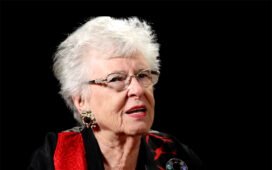(RNS) — The new prison drama “Sing Sing” points the camera at the humanity of men who have been imprisoned, touching on themes of faith, hope, love, confession and redemption — and employs those formerly incarcerated to play on-screen versions of themselves.
Based on the real-life story of the maximum security prison’s Rehabilitation Through the Arts (RTA) program, founded in 1996, the film follows inmates who form a theater troupe while serving their sentences, processing their emotions through musical performance and acting.
The cast includes Academy Award-nominated actors Colman Domingo and Paul Raci. Domingo plays John “Divine G” Whitfield, one of the founding members of RTA, imprisoned for a crime he didn’t commit. Raci plays Brent Buell, a playwright and theater director who volunteered at the RTA program at Sing Sing for more than a decade.
Austin-based director Greg Kwedar said the film is “a movie about the landscape of the human face” and the “thousands of stories” a face tells.
“It’s a radical act where we’re filming too because (in prison), everything is designed to pull away from humanity,” Kwedar said. “So in the film, it’s almost like an act of rebellion to draw close and to actually look someone in the eyes and to hear their names, stories, failures, dreams and hopes.”
In a scene where participants audition to star in RTA’s latest multi-genre play “Breakin’ the Mummy’s Code,” the camera captures each facial expression up close. Kwedar said that he and his team realized that the whole scene was characterized by an ambience of confession.
“It’s my favorite scene in the movie,” Kwedar said.

The cast films a scene in “Sing Sing.” (Photo courtesy A24)
There was understandable apprehension for those formerly incarcerated to step back into the walls of a prison to film. Scenes on the outside of Sing Sing’s facility were filmed on location, but most of the film’s scenes were shot at the decommissioned Downstate Correctional facility in the Hudson Valley region of New York.
“No one wants to voluntarily walk back inside of a prison or put on a prison uniform because that prison uniform is an identification. The reason why (the uniform is) green is because it separates you from the officers who wear blue,” said Clarence “Divine Eye” Maclin, who was released from Sing Sing in 2012 and plays a younger and modified version of himself. In the film, Maclin starts as a skeptic of Divine G and the RTA theater troupe, not seeing how performing Shakespeare monologues offers any form of catharsis to the harsh realities of prison life.
For the real-life Divine G, he’s grateful the film showcases how tenderness and love can still be present between men, despite the brutality and harshness of the criminal legal system. G and Colman Domingo worked closely throughout the filming process (with the two even sharing a scene together where G makes a cameo appearance). G has a master’s in theological studies from New York Theological Seminary, and his faith in God has been integral in processing his time at Sing Sing.
“The essence of our film deals with humanity, healing and hope … it deals with art in its transformative and rehabilitative power,” he said. “When you deal with themes of this magnitude … you can’t help but look at the issue of the Holy Spirit and this issue of people being motivated by the love God shares and would like us to exhibit to each other.”

“Sing Sing” film poster. (Image courtesy A24)
Divine G’s faith was so evident for Domingo that the actor felt comfortable portraying aspects of G’s faith on-screen without much conversation or consultation — Domingo knew that G believed in something bigger than himself, he said.
“Looking at someone who is wrongly accused of a crime, who’s in for a very long time, who still chooses hope and to advocate for others, and then for that person to say … ‘I’ll advocate for others too’ … that is faith, that is God,” Domingo said. “People can tell you that someone has faith but it’s really all in one’s practices and actions.”
The cast and crew hope that the film spotlights the restorative work of RTA, where less than 3% of the alumni return to prison. The program at Sing Sing is nationally renowned and supported by the local community, Broadway actors and churches.
“There’s something about faith in the middle of this whole program,” Domingo said. “There’s a generosity of spirit, which is about looking after humanity and holding up a mirror to each other and telling stories.”
Kwedar hopes that more people will enter into the mantra of RTA, to trust the healing process.
“I think a lot of people in the faith community will see faith as also a journey and process, one that is better to walk not alone but with others,” he said. “To trust the process is an act of faith.”
The success of RTA depends in part on the men becoming vulnerable with their true selves and emotions.
“That’s something that oftentimes we’re very afraid to do because there’s a lot of fear in being truly seen, but there’s something quite electric when you actually present your deepest self to someone and you realize ‘My soul is worthy of love,’” Kwedar said.
For G, he hopes that the film also would inspire people to more seriously take the Gospel’s call to visit those in prison.
“They are the ones who are the most downtrodden,” he said. “The reality of life is that when a person is incarcerated and they get abandoned, they’re left without access to the spirit of God. People can become bitter, and you don’t want them to leave prison bitter. So just going to prison and showing them love can be a healing thing.”
For Maclin, he hopes that the film underscores that people in prison “didn’t leave the human race because they got sentenced.”
“We’re all people here,” he said.















